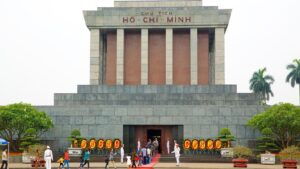Ho Chi Minh Mausoleum is the place to place the body of Uncle Ho – the great leader of our nation. Any Vietnamese or international visitor traveling to Hanoi will first visit the beloved father of the country.
Let’s learn about Ho Chi Minh Mausoleum in the article below.
“Our nation, our people, our country have borne the President Ho, a great national hero, and it is he who has brightened our nation, our people, our country”. …
On September 2, 1969, President Ho Chi Minh; was an outstanding leader; National Liberation Heroes; eminent international communist soldier; The cultural celebrity of humanity has entered eternity; leaving infinite mourning for the entire Vietnamese people and international companionship.
According to the earnest aspirations of the entire Party, the entire people, and the entire army, the Politburo of the Central Party decided: “With infinite love and gratitude to President Ho Chi Minh, we must do so to the extent that for the best part, with the task of preserving the body of President Ho Chi Minh and building his Mausoleum “.
General information
Ho Chi Minh mausoleum is a monumental and majestic architectural work; Mausoleum is 21.6 meters high, and 31 meters wide surface. The wings opened to both sides.
The lower part of the Mausoleum is paved with dark marble including three floors, the upper floor is smaller than the lower one, forming a massive three-tiered one.
The uniqueness of the national architecture has created a firm and dignified position for the Tomb.
The roof of Uncle Ho’s Mausoleum also forms a gentle and elegant three-tier with diagonal lines; making the mausoleum roof both neat and simple features of modern architecture, while revealing the soft and flexible appearance of the curved roof of traditional ethnic architecture.
Under the roof of the mausoleum, the four sides are lined with rows of tall, large columns of silver-gray marble.
On the morning of August 29, 1975, the Party and State held a solemn inauguration ceremony of the Ho Chi Minh Mausoleum and brought him to rest forever here, in the heart of the entire nation.
Where is Ho Chi Minh Mausoleum?
Ho Chi Minh Mausoleum is located at 2 Hung Vuong, Dien Ban ward, Ba Dinh district, Hanoi city.
How to get to Ho Chi Minh Mausoleum
Ho Chi Minh Mausoleum is now located at the old platform in the middle of Ba Dinh Square, where President Ho Chi Minh used to preside over meetings. To get to the address of Ho Chi Minh Mausoleum, you can travel by public car, which is very convenient.
if traveling by personal means such as car, motorbike, or bicycle remember to note the two parking spots:
- Ong Ich Khiem Street, opposite the Mausoleum Guard Command
- Ngoc Ha Street, the entrance to Ho Chi Minh Museum
If you choose to take the bus, you can refer to some routes that pass through Ba Dinh Square as follows:
- Bus number 09: Lakeside – Lakeside
- Bus number 33: Yen Nghia bus station – Xuan Dinh
- Bus number 22: Gia Lam – Kim Ma bus station
- Bus number 45: Times City – Nam Thang Long Bus Station
- Bus number 50: Long Bien – National Stadium
Opening hours of Ho Chi Minh Mausoleum
- In the summer, from April to the end of October, the mausoleum is open from 7:30 am to 10:30 am. On Saturdays, Sundays, and other holidays, the mausoleum is open from 7:30 am to 11 am.
- In winter, from November to the end of March next year, the mausoleum is open from 8:00 am to 11:00 am. For Saturday, Sunday, and public holidays, the mausoleum is open from 8 am to 11:30 am.
Ho Chi Minh mausoleum is usually open in the mornings of the week except for Mondays and Fridays.
However, on special days such as the 1st of Lunar New Year, May 19 (Uncle Ho’s birthday), and September 2 (National Day) that coincide on Monday or Friday, the mausoleum will still be open.
– Admission fee for Ho Chi Minh’s mausoleum with foreign tourists is 40,000 VND / time; and 40,000 VND/ ticket to visit Uncle Ho’s stilt house, where Uncle Ho used to live.
– For Vietnamese, admission is free.
Ba Dinh cultural and historical relic cluster
Ho Chi Minh Mausoleum
Monument to Heroes and Martyrs
The Monument to Heroes and Martyrs who sacrificed for the independence and freedom of the Fatherland is located on Bac Son Street, opposite Ho Chi Minh Mausoleum, next to Thang Long Imperial Citadel and Ba Dinh Hall.

Photo: nhandan.vn
This is a position of profound political, cultural, and historical significance. This is really one of the solemn and sacred places of the Vietnamese people.
Ba Dinh Square
Ba Dinh Square is the largest square in Vietnam, located on Hung Vuong Street, in front of the Ho Chi Minh Mausoleum.
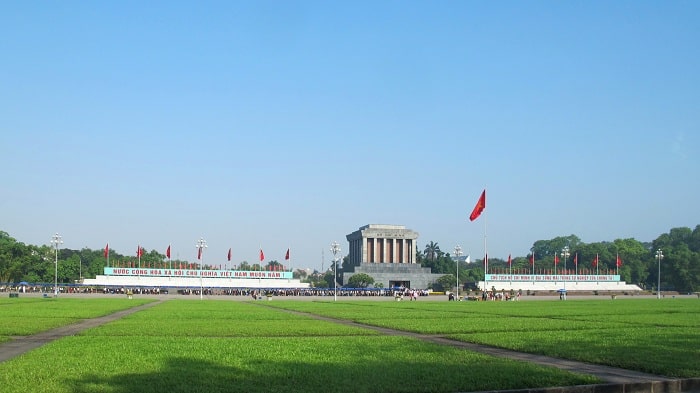
Ba Dinh Square has a large campus with many large grass squares that are images of mats spread on communal houses in ancient Vietnamese villages, interspersed with a 1.4 m wide walkway. In the middle of the square is the national flagpole.
Relics of President Ho Chi Minh at Da Chong, Ba Vi, Hanoi
Relics of President Ho Chi Minh at Da Chong in Ba Vi district, Hanoi city (former Ha Tay), about 25 km west of Son Tay town. The area is 234 ha, mostly forested hills, with 2 large lakes.
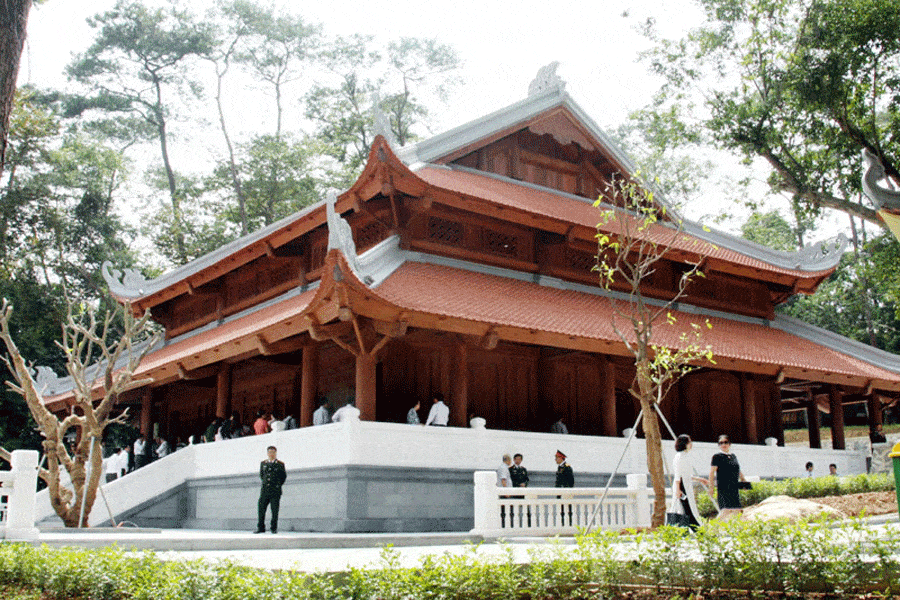
This place has many tapered rocks like spikes, spears seem to grow on the ground, maybe that’s why the locals call this place Da Chong.
The relic is the place where Uncle Ho chose to be the base of the Central Committee (1960-1969); Later, the Politburo chose to keep Uncle Ho’s body during the war years (1969-1975), which became a relic of great historical-cultural value.
Ho Chi Minh Museum
The museum started construction on August 31, 1985, and protested on May 19, 1990, the 100th birthday anniversary of President Ho Chi Minh.
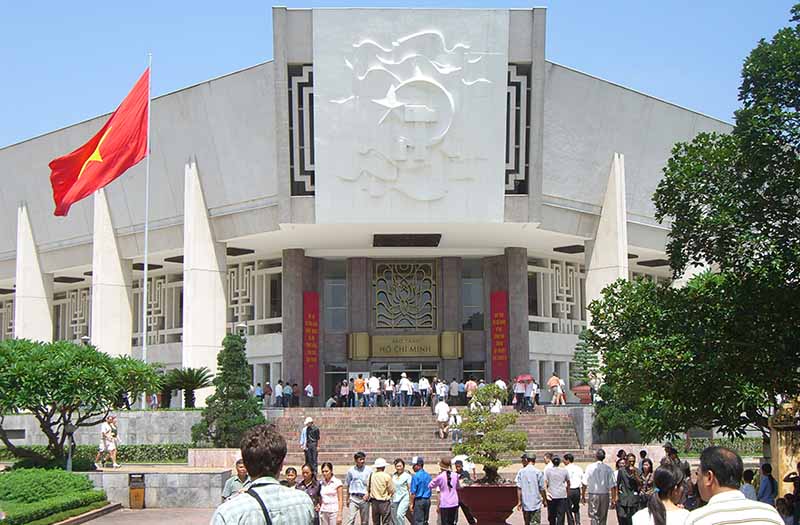
Ho Chi Minh Museum was built according to the aspirations of the Vietnamese people to express gratitude and forever remember the great merits of President Ho Chi Minh.
President Ho Chi Minh’s relic site at the Presidential Palace
This relic complex has become an important memorial area related to President Ho Chi Minh’s 15 years of life and work from December 1954 to September 1969.
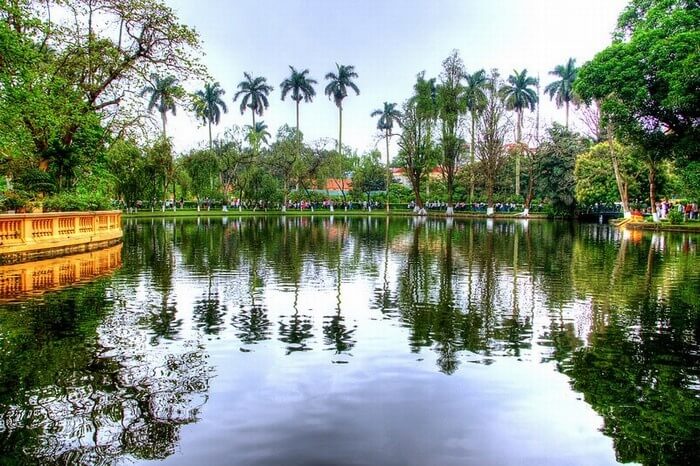
Uncle Ho’s fish pond
Here, visitors will visit the Presidential Palace, fish pond, climbing trellis, orchard, car, 1954 house, especially the historic stilt house of President Ho Chi Minh.
Journey to visit Ho Chi Minh Mausoleum
Normally, visitors’ itineraries will be arranged in sequence. The first is to visit House on stilts, where Uncle Ho used to live in the past. Next is Uncle Ho’s fish pond and then the Ho Chi Minh museum. The last place is to visit the One Pillar Pagoda.
On holidays, visitors will visit quite a lot, so the queue is a bit long. Inside, you’ll see signposts. Follow that and follow the line ahead.
From the mausoleum leading to Uncle Ho’s stilt house, the natural landscape is extremely poetic. This place has both a lake and a garden, the air is very cool and fresh.
Coming to the Presidential Palace, you will know more about Uncle Ho’s life and career. Come to the simple stilt house, you will see his simple life.
Finally, you can visit One Pillar Pagoda. This monument has a very unique architecture. This is considered a thousand-year-old lotus in the heart of the capital.
One Pillar Pagoda is also a symbol for the image of the capital. If you visit Hanoi, don’t forget to come here!
Flag raising and lowering ceremony at Ho Chi Minh Mausoleum
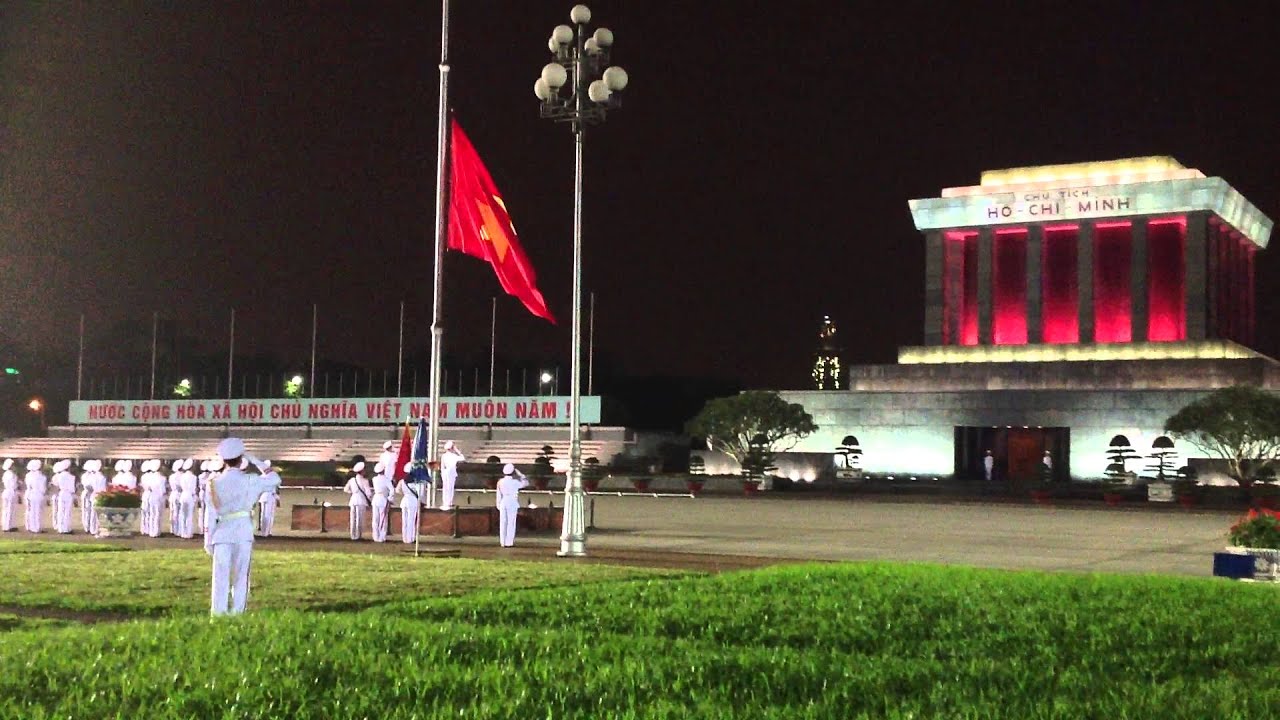
At Uncle Ho’s mausoleum, the flag raising ceremony and the flag lowering ceremony will be held in both morning and evening. This is a national ceremony, the morning is performed at 6 am and at 9 pm every day the flag lowering ceremony will take place.
Notes and dress codes
- Costumes when visiting Uncle Ho’s mausoleum: Dress neatly, and politely, and do not wear too short or revealing skirts, which are offensive.
- Attitude: Gentle, softly speaking, not causing noise, lined up in order when entering Uncle Ho’s mausoleum. When entering the tomb, take off your hat and do not put your hands in the bag.
- You can bring a phone or a camera, but do not take pictures or recordings in restricted areas, especially inside the mausoleum.
- Children aged 3 and over are allowed to enter the mausoleum.


